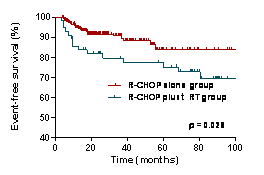Abstract
Introduction
Although several previous studies addressed the role of radiation in treating localized diffuse large B-cell lymphoma (DLBCL), chemotherapy alone has shown promising efficacy with the emergence of Rituximab. Thus, we evaluated the clinical efficacy outcomes and failure patterns of patients with localized DLBCL according to two different treatment strategies, either 6 or more cycles of R-CHOP chemotherapy alone or 3 or 4 cycles of R-CHOP followed by involved field radiotherapy (IFRT).
Methods
A prospectively collected database from 21 tertiary centers participating the Consortium for Improving Survival of Lymphoma (CISL), built up for PROCESS study (NCT01202448) for secondary central nervous system involvement in DLBCL, was recruited for current study in addition to the Asan Medical Center (AMC) Lymphoma Registry. CISL database and AMC lymphoma registry consisted of data from patients with newly diagnosed DLBCL between August 2010 and August 2012, and between February 2004 and February 2012, respectively. Inclusion criteria were localized (stage I or II), non-bulky (<10cm in longest diameter) DLBCL treated with R-CHOP as 1st line chemotherapy, and patients either who received 6 or more cycles of R-CHOP chemotherapy only (R-CHOP alone group) or received 3 or 4 cycles of R-CHOP chemotherapy followed by IFRT (R-CHOP plus RT group). Comparisons of clinicopathologic parameters, clinical outcomes and the patterns of relapse were performed between two groups. The types of relapse were classified as either locoregional or distant, according to whether it involves any separate region from primary sites. Efficacy outcomes included complete response (CR) rate, 2-year overall survival (OS) rate, and 2-year event-free survival (EFS) rate.
Results
A total of 357 patients (CISL prospective cohort: 161 patients, AMC registry: 196 patients) were eligible for the analyses. Two hundred ninety nine patients (83.5%) received 6 or more cycles of R-CHOP chemotherapy alone, and 58 patients (16.2%) underwent 3 or 4 cycles of R-CHOP followed by IFRT. Median age was 54 years (range, 16-87). During the median follow-up of 24 months (range, 4-116 months), 35 patients (9.8%) experienced relapse, and 22 patients (6.1%) died. Two-year OS and EFS rate was 94.7% and 89.9%, respectively, and 345 out of 357 patients (96.6%) achieved CR. Comparing R-CHOP alone to R-CHOP plus RT group, there was no significant difference in clinicopathologic parameters. R-CHOP alone could achieve significantly higher CR rate of 97.7 % than 91.4% of R-CHOP plus RT group (p = 0.030). Two-year OS and EFS were significantly longer in R-CHOP alone group than R-CHOP plus RT group (96.1 vs 89.9 %, p = 0.029 and 91.7% vs 81.8%, p= 0.028) (Figure 1). Relapse rate was significantly lower in R-CHOP alone group compared with R-CHOP plus RT group than group (7.4% vs 22.4%, p=0.001), and distant relapses were also significantly lower (15.5% vs 2.7%, p<0.001). In addition, even only in relapsed patients, R-CHOP alone group showed lower incidence of distant relapses with marginal statistical significance (36.4% vs 69.2 %, p=0.062) (Table 1).
Conclusion
In our cohort, R-CHOP alone for six to eight cycles without IFRT could achieve significantly higher 2-year OS and EFS rate as well as CR compared with R-CHOP plus RT group. In addition, the rate of relapse and systemic failure were significantly lower in R-CHOP alone group, which altogether warrant further validation in prospective trial.
Explorative comparison of overall clinical outcomes and patterns of relapse between two subgroups: patients who underwent six or more cycles of R-CHOP chemotherapy alone and who underwent 3 or 4 cycles of R-CHOP followed by IFRT
| . | Total (%) . | R-CHOP alone group (%) . | R-CHOP plus RT group (%) . | P -value . |
|---|---|---|---|---|
| Number of patients | 357 (100) | 299 (83.5) | 58 (16.2) | |
| Treatment response | ||||
| Complete response | 345 (96.6) | 292 (97.7) | 53 (91.4) | 0.030 |
| Overall response | 351 (98.3) | 294 (98.3) | 57 (98.3) | 1.000 |
| Rate of relapse | 35 (9.8%) | 14 (7.4) | 11 (22.4) | < 0.001 |
| Median time to relapse (95% CI) | 11 (7-15) | 11 (8-14) | 10 (5-14) | 0.346 |
| Pattern of relapse | < 0.001 (0.062) | |||
| Locoregional | 14 (4.7) (63.6) | 4 (6.9) (30.8) | ||
| Distant | 8 (2.7) (36.4) | 9 (15.5) (69.2) |
| . | Total (%) . | R-CHOP alone group (%) . | R-CHOP plus RT group (%) . | P -value . |
|---|---|---|---|---|
| Number of patients | 357 (100) | 299 (83.5) | 58 (16.2) | |
| Treatment response | ||||
| Complete response | 345 (96.6) | 292 (97.7) | 53 (91.4) | 0.030 |
| Overall response | 351 (98.3) | 294 (98.3) | 57 (98.3) | 1.000 |
| Rate of relapse | 35 (9.8%) | 14 (7.4) | 11 (22.4) | < 0.001 |
| Median time to relapse (95% CI) | 11 (7-15) | 11 (8-14) | 10 (5-14) | 0.346 |
| Pattern of relapse | < 0.001 (0.062) | |||
| Locoregional | 14 (4.7) (63.6) | 4 (6.9) (30.8) | ||
| Distant | 8 (2.7) (36.4) | 9 (15.5) (69.2) |
Comparison of overall survival and event-free survival in two subgroups: patients who underwent six or more cycles of R-CHOP chemotherapy alone and who underwent 3 or 4 cycles of R-CHOP followed by IFRT
Comparison of overall survival and event-free survival in two subgroups: patients who underwent six or more cycles of R-CHOP chemotherapy alone and who underwent 3 or 4 cycles of R-CHOP followed by IFRT
No relevant conflicts of interest to declare.
Author notes
Asterisk with author names denotes non-ASH members.



This feature is available to Subscribers Only
Sign In or Create an Account Close Modal